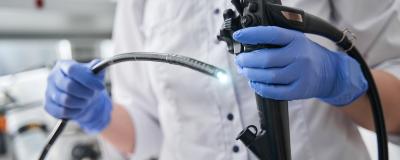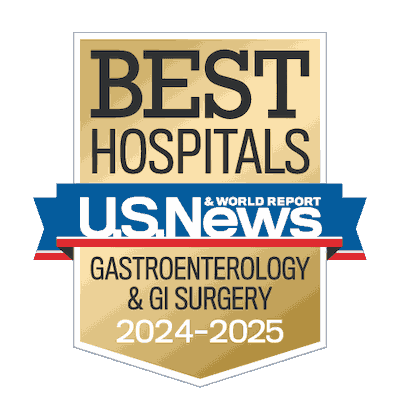The Rush Approach to Endoscopic Sleeve Gastroplasty
Endoscopic sleeve gastroplasty, or ESG, is a minimally invasive, non-surgical procedure that reduces the size and volume of the stomach. After the ESG, the stomach is usually reduced by about 60% to 70%, around the size of a banana. It allows patients to feel full faster, causing them to eat less food and lose weight. It’s one of the most common endobariatric procedures performed at Rush.
ESG is a tool that can be used to jumpstart patients on their weight loss. Our entire endoscopic bariatric team is here to set you up for success in your weight loss efforts. We have a team that includes physicians, dietitians and behavioral psychologists who can address your needs during recovery.

What to Expect Before, During and After Endoscopic Sleeve Gastroplasty
Before your ESG procedure, you’ll get an evaluation from a medical team that includes a Rush gastroenterology specialist and a dietitian. They will go over your medical, physical, behavioral and dietary history. They may recommend working with a dietitian or a psychologist if they can help with risky eating behavior or recommend lifestyle modifications.
If you’re approved for an ESG, your doctor will likely prescribe medications that you’ll need to pick up from your local pharmacy prior to the procedure. These medications can help prevent infections and control common symptoms after the ESG, including nausea or abdominal pain. The day before the procedure, you’ll start a liquid diet and not eat or drink anything after midnight.
On the day of your procedure, you will meet with the endobariatric team. Since the ESG is not surgery, there are no cuts made during it, so you will not have any scars or permanent changes to your internal anatomy. Instead, a doctor inserts a long, flexible tube called an endoscope through your mouth. They then use an endoscopic device to place stitches that reduce your stomach size by up to 70%.
Your endoscopic sleeve gastroplasty doctor can complete the procedure in about an hour. You are fully sedated during that time.
After the procedure is finished, your care team will give you some fluids and watch you in recovery for about two to four hours to make sure you’re doing well. About 90% of patients go home the same day. Most patients can return to work after three to five days.
With the endoscopic stitches in place, your stomach cannot expand as much. Your capacity for food intake will be smaller, resulting in fewer calories and weight loss. Research also suggests ESG slows down digestion, allowing you to feel full longer.
Most patients lose, on average, around 15% to 20% of their total body weight in the first year. By sticking to weight loss and exercise regimens, patients can keep the weight off for many years.
Why Should You Get Endoscopic Sleeve Gastroplasty?
Many people with obesity have trouble losing weight through diet and exercise alone. Also, many people develop weight-related medical conditions, including the following:
- Diabetes
- Fatty liver disease
- Fertility issues
- High blood pressure
- Severe arthritis
- Sleep apnea
Some patients may also need to lose weight for surgical procedures, such as transplant or joint replacement.
If you struggle with weight loss or weight-related conditions, a minimally invasive endoscopic sleeve gastroplasty may help you lose weight, keep it off and gain self-confidence.
Who Is a Good Candidate for Endoscopic Sleeve Gastroplasty?
Rush endobariatric services works with adults who have a BMI between 30 and 50 who do not qualify for or may not be interested in bariatric surgery. If you’ve tried other ways of losing weight and haven’t seen success, this procedure may be right for you.
Patients may not be good candidates for ESG if any of the following apply to them:
- History of bleeding disorders or blood clots
- Family or personal history of stomach cancer
- Severe liver cirrhosis
- Active smoker
- Eating disorder that prevents adhering to a diet
- Severe heart or pulmonary disease
Endoscopic Sleeve Gastroplasty Second Opinion Services
If you are considering endoscopic sleeve gastroplasty or your doctor has recommended it, you can call Rush at (312) 942-8651 for more information or for a second opinion.
We offer virtual appointments and in-person visits at our clinic in Oak Brook, Illinois, and at Rush University Medical Center in Chicago.
Rush Excellence in Endoscopic Sleeve Gastroplasty
- Fellowship-trained for optimal weight loss care: With dual board certifications in gastroenterology and obesity medicine, Christopher Chapman, MD, a gastroenterologist at Rush, is here to jump-start your weight loss. He is one of the only fellowship-trained gastroenterologist in the Chicago area offering endoscopic sleeve gastroplasty. He has performed the most endoscopic sleeve gastroplasty procedures in Chicago and serves as a teacher for the procedure across the country.
- Support from a system you trust: U.S. News & World Report includes Rush on its Best Hospitals Honor Roll and ranks Rush as one of the nation’s best hospitals for gastroenterology.
- A team approach: From nurses to pharmacists, our team is well-equipped to work with patients who need an endoscopic procedure. If you need other care as part of your weight loss experience, we have a broad range of trained specialists at your fingertips. Our collaborative approach means you can get quick access to any other medical care you need — before, during and after your procedure.
- Close to home: If you’re considering an endoscopic sleeve gastroplasty, you don’t have to travel to get world-class care. We offer virtual visits and consultations, both for those in the region and those farther away. Rush is one of the only systems with robust experience doing ESG in Chicago and the surrounding area.
FAQs About Endoscopic Sleeve Gastroplasty at Rush
Patients who adhere to their diet and exercise recommendations after the procedure often see durable weight loss for many years. Since Dr. Chapman began offering the procedure in 2017, many patients from that time are still seeing the weight loss and benefits of their ESG.
On average, patients can expect to lose 15% to 20% of their total body weight by one year. Most patients lose about 5% of their total body weight within the first month and 10% in the first 3 months.
A sleeve gastrectomy is a surgery, so it is more invasive and carries a few more risks than the minimally invasive ESG procedure. These risks include sleeve leak, stenosis of the sleeve and new or worsening acid reflux disease.
ESG has reduced risks with about a 2 to 3% risk of serious complication. ESG is also likely to lead to quicker recovery compared to surgery, which means less time away from work and usual activities.
While endoscopic sleeve gastroplasty is less invasive and has a lower risk of serious side effects, surgical sleeve gastrectomy generally leads to greater weight loss overall and may lead to longer-lasting weight loss. Patients also tend to lose weight more quickly from sleeve gastrectomy than ESG.
A successful endoscopic sleeve gastroplasty leads to at least 10% total body weight loss. Over 90% of patients who get the procedure achieve these results. Our ESG team works with dietitians and psychologists to give each patient the best chance of success. Follow-up visits and sticking to a diet and exercise plan will also improve patients’ chances of success.






